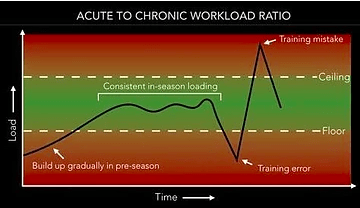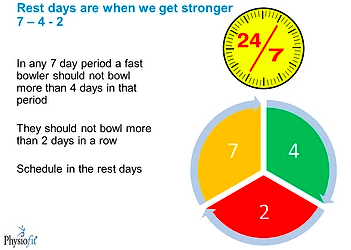
The body has the most amazing capacity to adapt to any stress or load placed on it providing that it has time to do so. In a study, athletes who trained at higher overall loads had 5 x fewer injuries than those who trained at lower overall workloads. If you give your body time to adapt to a new level of work, it can strengthen itself to protect against injury.
Injuries occur with not too much training but…
1. Training prescription error
Low loads – not fit enough or not bowled enough pre-season
Acute, excessive spikes in load – sudden increase in bowling or running for example
Large week-to-week changes in workload
2. Too little rest and recovery
3. Poor muscle strength and flexibility
The problems start when you have not done the appropriate training and you have a sudden spike in activity or intensity resulting in tissue overload and pain. Spikes can occur at the start of the winter nets, start of the season and when a backlog of games occurs after rain causes the cancellation of matches.
The key is to build up gradually to a level your body can adapt to and identify potential bottlenecks in the season when there are several games in a week which might create a “spike” in load and overload the body.
The ECB fast bowling directives for bowlers limit the number of balls a player can bowl in a day both in games and nets. This may suggest that providing you don’t bowl over that threshold you will be protected from injury. Research has highlighted that bowling too little or too much too soon is as greater a risk. Insufficient build-up of bowling pre-season or after the winter break means the muscles and bones have not been prepared for the sudden spike in bowling activity and the tissues are susceptible to injury in the 2-3 weeks that follow. Each player has their own unique sweet spot where they are bowling enough to be strong enough to be prepared for that load and yet not bowling so much that they break down.
If a player has not had the opportunity to play indoors and progressively build up in bowling intensity and volume, then it is essential that they do not start off the season bowling too many overs. Take several weeks to build up to your maximum number of overs. You need to start now and if you have left it too late then better to start slow than not at all!
How to prevent an injury in fast bowlers
1. Keep a training diary – Record the number and intensity of balls you bowl in every situation. Record all other sporting activity and gym sessions.
2. Calculate your workload
The recipe for injury prevention is based around the ratio between what you have done in the past as an average of the last 4 weeks versus this week’s load. Take the rolling average of the last 4 weeks and add no more than a 10%. Research has shown that as little as a 15% increase is enough to increase your injury risk substantially in some athletes. If session vary in intensity or across different sports calculate the intensity of the session out of 10.
Don’t forget that your workload for the week might also include other gym sessions and sports so make sure you don’t exclude the impact that will have on your body.
3. Rest and recovery are key
If there is excessive training intensity or volume or inadequate recovery between units of training, then performance reduces. The level of training and recovery that each athlete can tolerate at any given time varies between individuals. At times of greater stress an athlete can often tolerate less training load. Stronger athletes can tolerate more variability in load.
If an athlete ignores the messages the body is giving them such as fatigue, pain or illness, the risk of overtraining increases. The early signs include elevated resting heart rate, recurrent sore throats, loss of performance and injury. If these signs are ignored, the athlete can develop overtraining syndrome which can take months to recover from.
Recovery should begin immediately after training or playing to enhance repair, building of stronger muscles and to boost immunity. Window of 30 mins after finish to take on board fluid and protein with carbs. Make sure you eat protein at breakfast to encourage repair and keep blood sugars stable to deliver energy for exercise. Sleep is key to recovery. Avoid blue light for the hour before bed.

The important factor is giving the body time to adapt and become stronger. England Cricket Board suggests no more than 2 consecutive days of fast bowling with no more than 4 days of play in every 7-day period. We know that fast bowling over 2 consecutive days causes a small amount of bruising to the bones in the lower back even without the presence of any problems. If a rest day follows, the body has time to recognise the stress and react and become stronger, allowing minor stresses to heal and repair.
Any back pain that has been present for more than 2 weeks should be assumed to be a bone stress reaction until proven otherwise. No younger player should bowl if they have back pain during or after bowling. If you ignore the pain at the bone bruising phase, a stress fracture can quickly develop and end your season. If you get checked by a cricket specific physio you may prevent a fracture.
4. Our injury advice – rest is not always best
Traditionally the advice for overload injuries was rest. With careful management, reducing the load down to a level where the symptoms become more manageable ensures that the tissues get time to adapt. Rest will not change the reason why you might have developed pain and may result in you being weaker and less able to tolerate stress on the body. You either need to become stronger, more flexible or change your technique and workload. Something must change.
5. Get strong
It is essential to create a good foundation of strength and flexibility before the season starts and maintain
that during the season. Without adequate strength, players will break down as the intensity of games and net sessions increases. Focus on single leg balance, strength, hip turn and stride through the crease (hip and hamstring flexibility). A cricket specific screening will enable you to know what muscles are tight and which are weak so that you can target them quickly and effectively. Good technique is essential before weight is added.
6. Is my technique causing me pain?
There are many ways to bowl and some cause more problems than others. If your body has restrictions or weaknesses, then these will influence your bowling technique. If your body is conditioned appropriately for bowling, then it will tolerate techniques better, however, sometimes bad habits develop and even when you have got stronger these habits place undue stress on the body. Repetitive loading with poor technique will cause injury and this should be addressed by a suitably qualified bowling coach to highlight what changes should be made and how to implement these.
What can you do to avoid injury?
1. Avoid spikes in activity – plan ahead
2. Keep a training diary – record all bowling and sporting activity
3. Calculate your workload – average of the last 3 weeks plus 10% gives you this week’s load
4. Keep to the 7-4-2 rule – rest and recovery is key
5. Get strong with a cricket specific programme
6. Get your technique evaluated by a qualified bowling coach
7. Warm up before playing with cricket specific movements and stretch after playing
What can Physiofit do to help you avoid missing a vital part of the season?
Physiofit have extensive experience of screening cricketers of all ages and abilities which has been used with the Cheshire Emerging Players programme for over 12 years and can identify whether a problem is a physical weakness or a bowling technical fault. Physiofit can teach safe lifting techniques and build individual programmes for you. We also work with bowling coaches who can evaluate your technique.
This information is provided by Angela Jackson, Chartered Physiotherapist of Physiofit Ltd. It is a representation of her experience and research, but no liability is taken for the content of this document. It is meant as a guide to best practise and there will be variations for each individual child. For specific advice please do consult a physiotherapist with knowledge of sport and children. This material is not to be copied without the express permission of Physiofit Ltd.